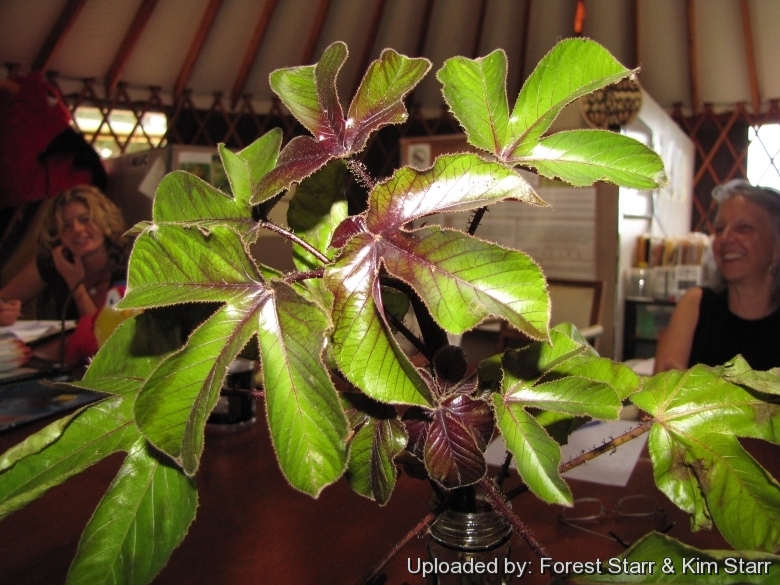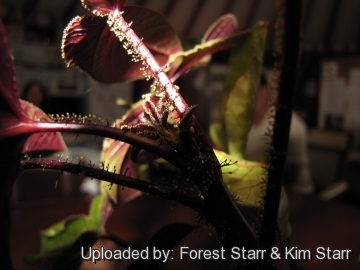Accepted Scientific Name: Jatropha gossypiifolia L.
Sp. Pl. 1006 (1753) L.

Manihot gossypiifolia (Jatropha gossypiifolia) Photo by: Forest Starr & Kim Starr
Leaves at Kahului, Maui, Hawaii (USA). October 28, 2009.
Origin and Habitat: The species is native to Mexico, the Caribbean (Antigua and Barbuda, Dominica, Guadeloupe, Puerto Rico, St. Kitts and Nevis and St. Lucia), Central America (Costa Rica, Honduras and Nicaragua) and tropical South America (Venezuela, Brazil, Bolivia, Colombia, Ecuador, Peru and Paraguay). It is widely naturalized in Asia (India and Indonesia) and Africa. It is a declared noxious weed in Puerto Rico and in northern Australia (Queensland, the Northern Territory and Western Australia). Also naturalised in south-eastern USA (i.e. Florida), on La Reunion in the Indian Ocean, and on several Pacific Islands (e.g. Hawaii, French Polynesia, Palau, New Caledonia and Guam). Sometimes grown as a garden plant.
Habitat and ecology: Is a bushy gregarious shrub that grows in grass lands, open woodlands, monsoon vine forests, in drier tropical environments, but is sometimes also naturalised in sub-tropical and semi-arid regions. It is a weed of degraded pastures, wastelands, open and disturbed areas and old or abandoned gardens. It can also grow on the seashore and is common along riverbanks and roadways. It is a major weed in Australia and Puerto Rico. It out-competes native vegetation and takes over extensive sections of river frontage reducing biodiversity. It is poisonous to native animals. Seeds may be spread short distances when they are explosively released, while most long range dispersal probably occurs in water or mud. Native meat ants also play an important role in the short-range dispersal of its seeds.
Synonyms:
See all synonyms of Jatropha gossypiifolia
Common Names include:
ENGLISH: Red fig-nut flower, Wild Physicnut, Cotton-leaved Physic-nut, Wild Cassava, Bellyache bush, Black physicnut, Purging nut, Cotton-leaf physic nut, Cotton-leaf jatropha, Cotton leaf physic nut, Black physic nut, American purging nut
ARABIC ( لعربية ): جتروفا قطنية الأوراق
BENGALI (বাংলা): Erenda, Laljeol, Lal Bheranda, Erenda, Laljeol, Lal Bheranda
CZECH (Čeština): Dávivec bavlníkolistý
FRENCH (Français): Manioc à feuilles de cotonier
HAITIAN CREOLE (Kreyòl ayisyen): Barachen
MALAYALAM (മലയാളം): ചുവന്ന കടലാവണക്ക്
Description: The bellyache bush (Jatropha gossypiifoliaSN|28997]]SN|28997]]) is a succulent-stemmed, shrub usually 0.6-1.5 metres high (occasionally up 4 m), with open sparse canopy that develops from a short, single-stemmed plant with 3 or 4 young leaves sprouting from the top. Young leaves are purple and sticky. Older leaves are deep green with edges covered in coarse, dark brown hairs. The small marron-red flowers with yellow centres appear in clusters. These are followed by cherry-sized seed pods that are poisonous. The contrast between the purple leaves and green immature fruits is something special. It releases a sticky, yellow, translucent sap when injured.
Similar species: Jatropha gossypiifoliaSN|28997]]SN|28997]] can be confused with castor oil plant (Ricinus communis) as both plants are frequently found in the same areas. Castor oil plant is usually taller than bellyache bush. The leaves are larger and clearly different, with more lobes (7 to 9), which are much more pointed and the fruit are much larger than those on the bellyache bush.
Stem: The older stems are relatively thick and either somewhat succulent or softly woody. These older stems contain a watery or soapy sap. The younger branches are herbaceous, succulent, purplish in colour and densely covered in small bristles with glandular tips (i.e. they are pubescent).
Leaves: Alternate, orbicular in outline, cordate at the base, digitate, 3-5 lobed beyond the middle, 5-12 cm in diameter purple and sticky when young and become bright green with age. Lobes obovate or obovate-lanceolate 12-18 mm broad, pointed, serrate, gland-toothed, ciliate, shortly pubescent on the margin, glabrous on both surfaces. Lateral nerves to each lobe about 9–12, slender, looped near the margin, distinct on both surfaces; veins rather lax, distinct below; petiole up to 12 cm long, furnished with numerous forked gland-tipped appendages resembling the stipules, slightly pubescent. Stipules multisect, about 4 mm long. Jatropha gossypiifoliaSN|28997]]SN|28997]] usually loses its leaves during the dry season (i.e. it is deciduous).
Inflorescence: Common peduncle, terminal to 10 cm long, partial ones cymose dichotomous, lax, bracts linear-lanceolate, acute, up to 12 mm long, stipitate, gland-toothed, glabrous. Male flowers more abundant female placed singly in the fork of the common peduncles.
Male flowers: Rather crowded. Calyx 5 leaved. Sepals lanceolate, pointed, 3 mm long, with numerous glandular teeth, very slightly pubescent. Corolla deeply 5 parted. Segments (petals) obovate, rounded at the apex, 4 mm long, 2-3 mm broad, entire, multistriate, glabrous dark purple. Nectariferous glands roundish slightly wrinkled placed at the feet of the stamens. Filaments 8-12 united from the base to the middle or to 3/4 the length of the corolla. Anthers deep yellow 2 cleft ovate.
Female flowers: Calyx and corolla the same as in the male flower. Petals absent. Nectary 0. Ovary thinly pubescent nearly round. Style erect, swollen 3 cleft from the base. Stigmas widened bifid at the apex.
Blooming season: Flowers throughout the year where adequate moisture and temperature is available,but mostly during late summer and autumn .
Fruit(capsule): 12 mm long, glabrous, smooth, ovate or nearly so, 3 cornered retuse, 3 celled, containing 3seeds. These fruit are initially glossy green in colour but turn brown and dry as they mature. The dry fruits is seldom seen because it split open explosively when dry, scattering the seed all around.
Seeds: Solitary, oblong-ellipsoid, 7-8 mm long and about 4 mm wide, greyish-yellow, orange-brown or dark brown in colour, slightly mottled; caruncle about 10-segmentate.
Bibliography: Major references and further lectures
1) Forest & Kim Starr “Jatropha gossypifolia (Bellyache bush, cotton leaved jatropha)”. Plants of Hawaii. <http://www.starrenvironmental.com>. Web. 27 Sep. 2014.
2) Wikipedia contributors. "Jatropha gossypifolia." Wikipedia, The Free Encyclopedia. Wikipedia, The Free Encyclopedia, 14 May. 2014. Web. 27 Sep. 2014.
3) Sydenham Teast Edwards, John Lindley “The Botanical Register: Consisting of Coloured Figures of Exotic Plants Cultivated in British Gardens with Their History and Mode of Treatment” Volume 9 Copertina anteriore 1823
4) Nasir El Bassam ”Handbook of Bioenergy Crops: A Complete Reference to Species, Development and Applications” Earthscan, 2010
5) J. G. Baker, with additions by C. H. Wright. “Flora of Tropical Africa” Vol 6 Part 1, page 441 1913
6) The State of Queensland (Department of Agriculture, Fisheries and Forestry)“Bellyache bush (Jatropha gossypiifolia)” Queensland Government. <http://www.daff.qld.gov.au>. Web. 27 Sep. 2014.
 Leaves and stems with glandlike structures at Kahului, Maui, Hawaii (USA). October 28, 2009. (Jatropha gossypiifolia) Photo by: Forest Starr & Kim Starr
Leaves and stems with glandlike structures at Kahului, Maui, Hawaii (USA). October 28, 2009. (Jatropha gossypiifolia) Photo by: Forest Starr & Kim StarrSend a photo of this plant.The gallery now contains thousands of pictures, however it is possible to do even more. We are, of course, seeking photos of species not yet shown in the gallery but not only that, we are also looking for better pictures than those already present.
Read More... Cultivation and Propagation: The bellyache bush (Jatropha gossypiifoliaSN|28997]]SN|28997]]) is an adaptable species that does best in drier tropical areas and is undemanding on soil, being well adapted to poorer soils and full sun to light shade. This plant develops in a fashion similar to a sprawling shrub and is tolerant of heat and drought and cultivation is uncomplicated, but a weed, nevertheless! It shoots its seeds all over the place. And it's a really tricky plant to wipe when the garden becomes inundated with this Jatropha. Careful when planting this in a warm climate!!!
Growth rate: They can grow fast.
Soil: The plant grows best on well-drained soils with good aeration. Root growth is reduced on heavy soils. The plant can grow in wastelands and grows on almost any terrain, even on gravelly, sandy and saline soils. It can thrive in poor and stony soils. For pot culture a gritty, very free-draining compost is suitable, and clay pots help the plants to dry out between watering. Re-pot every 2-3 years.
Fertilization: Jatropha respond well to fertilizer (once every one to two months).
Waterings: They like only a short winter's rest and should be kept almost completely dry during the winter months. If the soil is allowed to be dry for too long root loss could follow but equally the same result would occur if the plants are both wet and cold. From March onwards the plant will begin to grow and watering should be increased gradually until late May when the plant should be in full growth. Water regularly during the summer so long as the plant pot is allowed to drain and not sit in a tray of water. During hot weather you may need to water the plants more frequently so long as the plant is actively growing. From late September watering should be reduced to force the plant to go in to a state of semi dormancy, by October you should be back in to the winter watering regime.
Hardiness: Tender, protect from frost . Temperature spring to autumn: nocturnal at least 18°C and diurnal up to 38°C. Wintering: nocturnal 12°C and diurnal 20°C or more.
Pruning: Generally not necessary to prune plants except to remove dead branches and leaves for a cleaner appearance in the landscape. However this species do tend to get sort of leggy and pruning is sometime necessary to keep hedged and pruned to maintain the shape. Repeatedly prunings also help to encourage new growth. The flowers only develop terminally (at the end of a stem), so a good ramification (plants presenting many branches) produces the greatest amount of fruits. .
Pest and diseases: The use of pesticides is rarely necessary, due to the pesticidal and fungicidal properties of the plant.
Propagation: Jatropha gossypiifoliaSN|28997]]SN|28997]] has limited natural vegetative propagation and is usually propagated by seed.
Warning: All the parts of the plant are considered as poisonous to humans and animals especially the seeds. When a plant get damaged it exudes a thick white milky sap known as latex. This latex is poisonous and particularly dangerous for the eyes, skin and mucous membranes. So pay extreme attention not to get any in your eyes or mouth. Cultivated plants must be handled carefully. If consumed severe nausea, vomiting, diarrhea, gastroenteritis, blindness are expected.
Uses: A decoction of the bark is used as an emmenagogue. The leaves are purgative; applied to boils, carbuncles, eczema and itches. Sap exudates taken from leaf petiole is mixed with molasses and given to cure dysentery. Seeds are drastic purgative and emetic, but they are said to cause insanity. Seed oil is used in skin diseases and as an external stimulant in rheumatism and paralytic affections. Regular brushing with the twigs keeps the teeth and gum disease free and cures tooth-ache. In netherlands Antilles they have traditionally been used here for skin conditions such as bites and stings. It is also a green dye plant.












